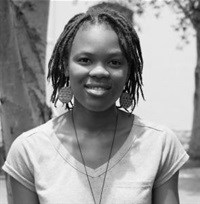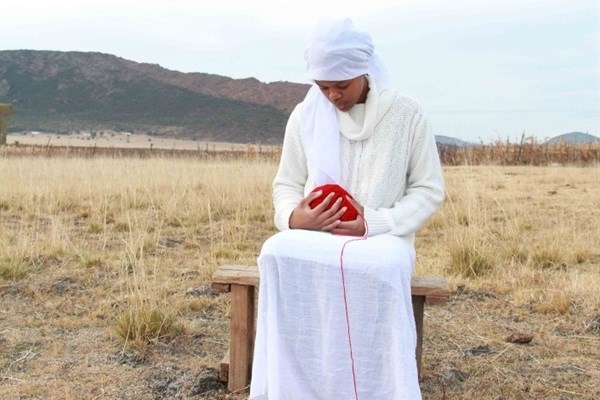#DesignIndaba2017: The URGENT design strength of feminine fire

Poetic designer and domestic design graduate Izykowicz was first talking to us through the screen from Poland – one of the only speakers to not appear live on the Arstcape stage, but she made up for it by presenting a video she’d created and watched for the first time herself as it played for us. The video explained her somewhat instinctive process in creating natural botanical smells or senses that are emitted when they’re matched to the stages of a woman’s natural biological cycle or individual sense of time to be worn as accessories in different sizes.
This was her graduation project.
Scent of a woman
In the video, she spoke of working with her hands, thinking with her legs and understanding her physical connection with the universe. The video was presented in chapters with her voice-over speaking of the ritual dance, the beginning and end of certain life phases that females go through and the need for a cold, peaceful and clean mind to be the best version of yourself.
The video explains it’s about when we want company, when we’re happy to be alone, and how we use our knowledge, senses, experiences and privacy to create ritual – hence the name Ritu, meaning ‘monthly’ in Sanskrit, for the aspect of ritual and performance. Izykowicz uses fresh clary sage to alleviate PMS symptoms, animal musk for the sexual nature of ovulation and garden sage to denote the cleansing nature of menstruation.
She took a day to get inspiration: the birth of a star and how it ties in with her own body cycles. The scents then emerge when you rub the pieces into the skin, reminding you to pay attention to your body and shifting temperament. Izykowicz incorporated the aroma into jewellery as it’s worn close to the body, so is the ideal vehicle to distribute the scent, to own your own scent and not let it own you.
Seeing and listening for that inner strength

Shifting focus from the scent of smell to the visual and also aural, Michaelis School of Fine Art graduate Msebenzi took to the stage next. She’s a South African photographer, who was born in 1991 and uses her own body in her work to narrate her personal journey as a woman, tackling social and cultural problems along the way. She started off on a powerful note, asking the audience to put their hands up if they’ve experienced sexual harassment in public spaces in the past week – anything from catcalling and unwanted attention to the more personal physical realm of being touched in private places.
With murmurs of surprise from the audience at the amount of raised limbs that responded, Msebenzi added the caveat that this situation is an urgent one to address, but not unique to SA. We live in a world that conditions rape culture. For example, last year, a student march took place against this, which resulted in cyber bullying.
Telling the tale of her own breaking point in this regards and proof that personal experience is more powerful than guessing at the story behind the curtain, Msebenzi shared how she was waiting for a bus when she saw a truck going past emblazoned with an image of a horizontal female. Attention elsewhere, out the corner of her eye she noticed a man coming towards her, dragging a bin. He squeezed her bum as he passed. She swung a blow at him and missed, hitting his bin instead. She was so angry, the sound echoed inside the bin. She then picked up a brick to attack him in retaliation, as with sexual harassment, the scars are on the inside. She didn’t get to throw the brick though as he apologised when he was a metre away from her, which she felt was sincere and honest, but the deeper message was that society has taught him that he’s entitled to her body, so that’s where she really needed to retaliate. As females, we’re considered as something to consume, even in public. We’re asked why we are dressed a certain way as 'clearly we want it'. That’s the true root of the problem we need to address.
Thinking back further, Msebenzi remembers her first kiss – unexpected on her part as it was with a perfect stranger who thrust his tongue down her throat, and she only learned about consent last year. It’s a difficult conversation, so we learn the art of silence. To change that, Msebenzi put a jacket on the washline, which became part of a body of work shot in the Eastern Cape, Western Cape and KwaZulu-Natal. While shooting she spoke to an old lady on the bus about harassment and remembered her own mother telling her not to let anyone touch her ‘here’ while in the bathroom as a child, which instilled a fear of being traumatised not just in public but in her own home. Her mother and grandmother share this fear, sleeping fully clothed with weapons under their beds. Msebenzi says these weapons symbolise both a sense of fear and immense resistance and power. (One of the weapons under her mother’s bed is a saw, so no one messes with her!)
Listening and art as resistance
Msebenzi took this all in and wanted images of herself fighting an invisible attacker, drawing on the idea that women in India dress in pink and physically attack males who attack women, making men the victims and taking back their own power.
On finding internal power, Msebenzi thought of the likes of Brenda Fassie who resonated strength just by existing. Looking at her photos, her mentor commented that the women are beautiful and glamorous, but they’re also clearly all listening. We are the listeners, as we want someone to listen to us in return. For Msebenzi, the process of creating becomes a way of healing, unpacking, figuring things out and at times finding solutions.
That’s what design’s all about.
Visit Kaizykowicz.com for more on Izykowicz’ Ritu, click here for more on Msebenzi, and visit Bizcommunity's Design Indaba special section for our latest coverage!




























